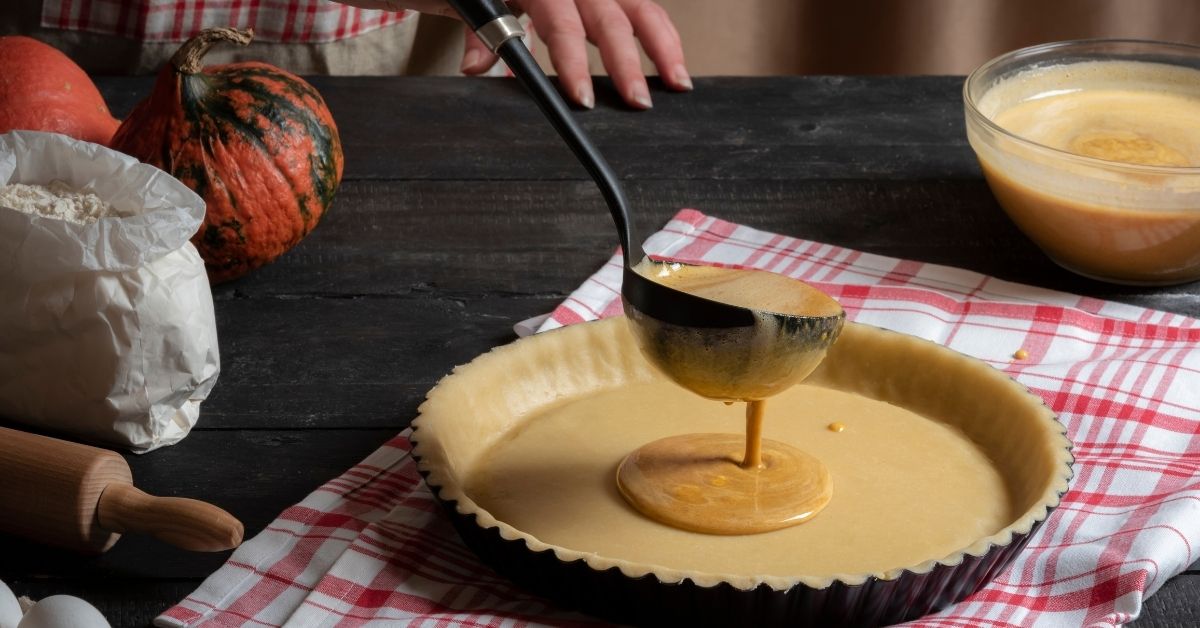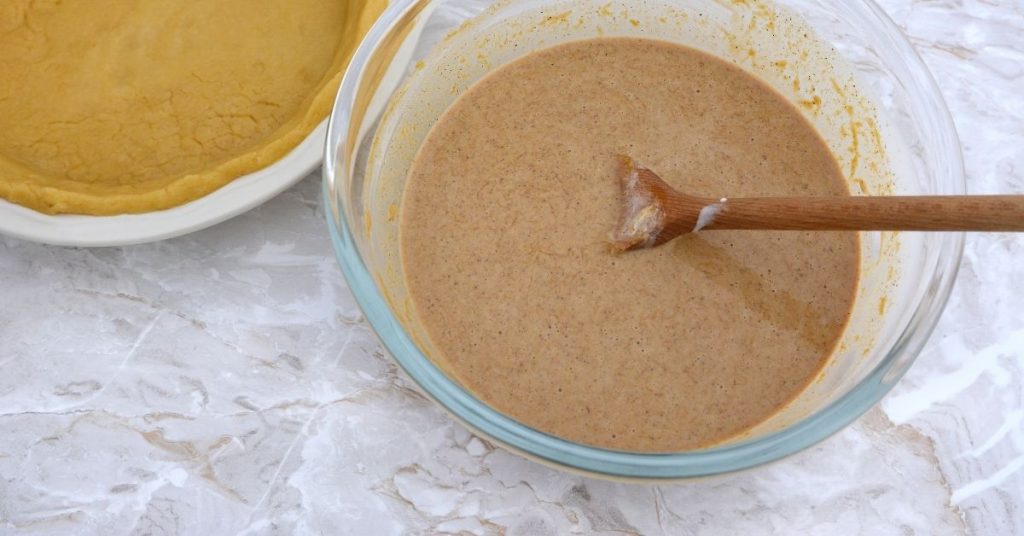Pumpkin Pie Filling Runny Before Baking: What Should It Look Like?

A well-baked pumpkin pie is truly a delight. But to get the perfect pumpkin pie, you need the perfect pie filling. But what should this filling look like before you put it in the oven? Should it be thick and cream or should pumpkin pie filling be runny before baking?
A typical pumpkin pie filling should have a runny consistency similar to melted ice cream or custard before you bake it. If the filling is any lighter then it might not set properly after baking. You can use cornstarch or add an extra egg to make the filling thicker.
A great filling is essential in baking a great pumpkin pie. So, in this article, we go over how to achieve the perfect consistency with your pumpkin pie filling, what to do if it is too runny or too thick as well as how to tell if the filling has been set properly.
Is Pumpkin Pie Filling Supposed to Be Runny Before Baking?
A pumpkin pie filling is something like a custard. As such, it should have the consistency of custard. So, the filling should be thicker than milk but not as thick as cream or puree. The consistency should be such that when you shake the bowl or crust, the filling should jiggle like a wave.

A pumpkin pie filling is typically made by mixing together pumpkin puree, milk or condensed milk or heavy cream, and various spices. Depending on the type of puree you use, the consistency of your filling is going to vary.
Normally, fresh pumpkin has a lot more water in them than canned pumpkin. So, if you use a fresh pumpkin to make the puree, it will invariably be runnier than canned pumpkin puree. The canned puree also has various thickening agents to get that consistency.
To summarize, if your pumpkin pie filling has a runny consistency, then it is okay because it has to be like that. You do not have to worry that the pie will not be set properly as this is how the filling should normally be. If it is any thicker or lighter, there are options you can try to fix it.
What Consistency Should Pumpkin Pie Filling Be Before Cooking?
Ideally, the consistency of your pumpkin pie filling should be like custard or melted ice cream. This is the consistency it should have before you put it in the oven. This will ensure that the pie is smooth and creamy once it is baked.
If the filling is very thick and heavy, then the pie will be more like fudge or a cake after you bake it. Conversely, if the filling has the same consistency as water or milk, then the pie will not set properly in the oven. This will lead to a runny pie, a trait that is desirable in some pies but not in a pumpkin pie.
Why Is Your Pumpkin Pie Filling too Runny?
If the filling you made for your pumpkin pie turns out to be more like soup than custard, there may be a few different reasons explaining it. Here are some of the common factors responsible for a runny pumpkin pie filling:
Using Fresh Pumpkin Instead of Canned Pumpkin
Fresh pumpkins tend to have more moisture than their canned counterparts. So, if you used fresh pumpkin to make the puree, the resulting filling can be too runny. Also, it could be a case that the pumpkin species you are using holds more water than usual. So, you have to take this into consideration as well.

Not Enough Eggs
Eggs do more than just make for a richer filling. Eggs, specifically the yolk, hold together other ingredients and give it a firmer structure. So, if you are not using the recommended number of eggs in the filling, you may end up with a runny filling that does not set properly.
Too Much Milk
Most pumpkin recipes will call for milk or half and half. But the milk to puree ratio is important. If you add too much milk, then the consistency of the filling will be exactly that of milk, which is a bit too runny for a pie.
How to Make Your Pumpkin Pie Filling Thicker?
So, you made your pumpkin pie filling and it turned out a bit too thin. Worry not because there are several measures you can take to reach your desired level of consistency. Here are some of the easier fixes for a runny filling:
Add Cornstarch
Many recipes will include cornstarch or similar starch-based thickeners. They all work the same way by absorbing the moisture in a mixture. This helps the filling to firm up in the oven and gives it a stable structure. For the same reasons, you can use flour instead of cornstarch.
Even if your recipe does not call for something similar, you can still use it to make your filling thicker. You do not have to worry about the pie turning into a cake with a bit of flour or cornstarch. And if the recipe already calls for it then simply add a little starch at a time. Stir the mixture until you get your desired consistency.
Add More Eggs
Eggs are pretty much essential in a pumpkin pie filling unless you are using some sort of a substitute. And as we have mentioned previously, the eggs play a vital role in making the filling thick and firm once it is done baking.
So, if you find that the consistency is too thin even after incorporating the specified number of eggs, try adding an additional egg yolk. Then stir the mixture thoroughly to see if it has thickened properly.
If the mixture has not thickened enough, try adding flour with the yolk. Because while an extra egg will help, adding too many will tamper with the taste of the pie.
Put It in the Fridge
If the pie is having trouble settling even after baking for the right amount of time, you can place the pie inside your fridge after it has cooled down. The cold temperature will cause the molecules to contract and make the pie filling firm. So, you would be able to cut the pie without worrying about a runny filling.
Roast and Strain Fresh Pumpkin
So, you want to make a pumpkin pie using the fresh produce you grow in your own garden. That is perfectly acceptable. But to make sure the extra water in a fresh pumpkin does not ruin your filling, you need to remove some of that moisture.
And the best way to do this would be to roast the pumpkin in an oven and then strain it through a sieve. Not only will the roasting process remove much of the extra moisture, but it will also endow the puree with a delicious smoky flavor. This is perfect for a pumpkin pie as it is one of the heartwarming desserts out there.
How to Roast and Strain Pumpkin Pie Puree?
Cut the ends of the pumpkin to create a flat surface on both ends. Slice the pumpkin into 4 or more pieces to make them more manageable. Use a spoon to scoop out the seeds. Place the slices on a tray lined with parchment pepper. Lightly drizzle with olive oil and put into a 400 °F oven. Leave it in the oven for 15 minutes.
Take the pumpkin out of the oven and peel the skin off. Then put all the toasted pumpkin into a food processor and grind until you get a smooth texture.
Now, put cheesecloth on a fine-mesh sieve. Then strain the puree through the sieve and leave it for a few minutes. Check to see if the puree has reached its appropriate consistency.
Can You Overcook Pumpkin Pie to Make It Thicker?
The runny filling is not typically a problem with pumpkin pie as the center will harden once it bakes in the oven. The longer you bake it, the drier and harder the filling will become as more moisture will start to evaporate. So, if your filling happens to be extra watery, you can keep it in the oven for a bit longer to dry it out.
Of course, you have to be wary of not over-baking the pie. Because an overbaked pie will have a rubbery texture that will not taste good at all. So, you can overcook the pumpkin pie for a few minutes, but not too long.
How Do You Tell If a Pumpkin Pie Is Done Baking?
As with any pie, you have to be mindful of how long your pumpkin pie is in the oven. Bake it for too long and the pie comes out with a rubbery texture. But if you do not bake it for long enough, the filing remains a liquid. The ideal texture is somewhere in the middle, where the center is soft yet firm enough to hold its shape.
How Do You Tell It Is Done without Cutting Into the Pie?
Well, there is a popular saying to judge how done your pie is – jiggle like Jell-O, not wiggle like a wave. Basically, the filling should be firm around the edges. So, when you shake the pie, the center jiggles like jelly. But if the center creates waves like a pond, then you know it has not settled properly.
Alternatively, you can do a visual check to see if the pie is done. The center should be darker than its original hue and the crust should have a light brown color. Now, this is not the most dependable or precise measurement tool. But it can help you gauge how cooked the pie is just by looking through the oven door.

Another method you can try is with a toothpick. It is similar to how you check a cake after baking it. Poke a toothpick through the center of the pie. If the pick comes out clean, then you know the filling has settled properly. If there is filling sticking to the toothpick, you still need to bake the pie for a bit longer.
Will Pumpkin Pie Thicken as It Cools?
The pie will naturally thicken as it cools down. The residual heat from the oven will keep the center warm for some time. This will make the filing softer. But when you let it cool down, the pie filling will become properly set, especially if you used any one of the thickening agents and/or an extra egg.
This is the reason why it is fine even if your pie is still a bit wobbly after you take it out of the oven. Because the pie will lose heat and become firm and set. Once the pie settles properly, you can place some ice cream or whipped cream on top.
Does Pumpkin Pie Rise When Baking?
As the pie heats up, the moisture inside it will start to evaporate. This will cause the pie filling to rise up a little near the center. The surrounding crust will turn brown and slight cracks will start to appear at the places where the filling meets the crust. Once the pie cools, the filling will constrict and the puff will relax.
To conclude, pumpkin pies are sort of the ultimate seasonal pie. But you can enjoy all its creamy sweetness whenever you want, be it on thanksgiving dinner, a lazy afternoon, or as a surprise morning breakfast.
